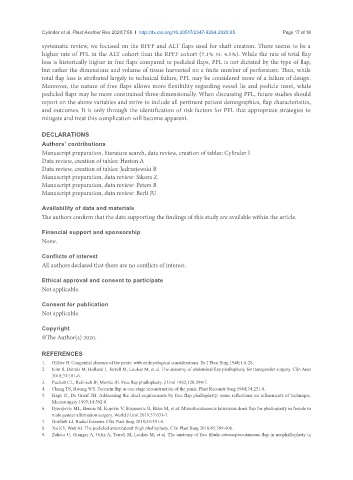Page 683 - Read Online
P. 683
Cylinder et al. Plast Aesthet Res 2020;7:58 I http://dx.doi.org/10.20517/2347-9264.2020.85 Page 17 of 18
systematic review, we focused on the RFFF and ALT flaps used for shaft creation. There seems to be a
higher rate of PFL in the ALT cohort than the RFFF cohort (7.1% vs. 4.5%). While the rate of total flap
loss is historically higher in free flaps compared to pedicled flaps, PFL is not dictated by the type of flap,
but rather the dimensions and volume of tissue harvested on a finite number of perforators. Thus, while
total flap loss is attributed largely to technical failure, PFL may be considered more of a failure of design.
Moreover, the nature of free flaps allows more flexibility regarding vessel lie and pedicle inset, while
pedicled flaps may be more constrained three-dimensionally. When discussing PFL, future studies should
report on the above variables and strive to include all pertinent patient demographics, flap characteristics,
and outcomes. It is only through the identification of risk factors for PFL that appropriate strategies to
mitigate and treat this complication will become apparent.
DECLARATIONS
Authors’ contributions
Manuscript preparation, literature search, data review, creation of tables: Cylinder I
Data review, creation of tables: Heston A
Data review, creation of tables: Jedrzejewski B
Manuscript preparation, data review: Sikora Z
Manuscript preparation, data review: Peters B
Manuscript preparation, data review: Berli JU
Availability of data and materials
The authors confirm that the data supporting the findings of this study are available within the article.
Financial support and sponsorship
None.
Conflicts of interest
All authors declared that there are no conflicts of interest.
Ethical approval and consent to participate
Not applicable.
Consent for publication
Not applicable.
Copyright
©The Author(s) 2020.
REFERENCES
1. Gillies H. Congenital absence of the penis: with embryological considerations. Br J Plast Surg 1948;1:8-28.
2. Kim S, Dennis M, Holland J, Terrell M, Loukas M, et al. The anatomy of abdominal flap phalloplasty for transgender surgery. Clin Anat
2018;31:181-6.
3. Puckett CL, Reinisch JF, Montie JE. Free flap phalloplasty. J Urol 1982;128:294-7.
4. Chang TS, Hwang WY. Forearm flap in one-stage reconstruction of the penis. Plast Reconstr Surg 1984;74:251-8.
5. Hage JJ, De Graaf FH. Addressing the ideal requirements by free flap phalloplasty: some reflections on refinements of technique.
Microsurgery 1993;14:592-8.
6. Djordjevic ML, Bencic M, Kojovic V, Stojanovic B, Bizic M, et al. Musculocutaneous latissimus dorsi flap for phalloplasty in female to
male gender affirmation surgery. World J Urol 2019;37:631-7.
7. Gottlieb LJ. Radial forearm. Clin Plast Surg 2018;45:391-8.
8. Xu KY, Watt AJ. The pedicled anterolateral thigh phalloplasty. Clin Plast Surg 2018;45:399-406.
9. Zaheer U, Granger A, Ortiz A, Terrell M, Loukas M, et al. The anatomy of free fibula osteoseptocutaneous flap in neophalloplasty in

